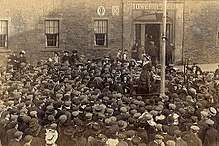Edith New
| Edith Bessie New | |
|---|---|
 by Peter Nairn of Hawick | |
| Born |
Edith Bessie New 17 March 1877 Swindon, England |
| Died |
2 January 1951 (age 73) Liskeard, England |
| Known for | first suffragette vandal |
Edith Bessie New (17 March 1877 – 2 January 1951) was an English suffragette. She was one of the first two suffragettes to use vandalism as a tactic. They were surprised to find their destruction was celebrated and they were pulled triumphantly by lines of suffragettes on their release in 1908.
Early life
She was born Edith Bessie New at 24 North Street Swindon. The daughter of Isabella (née Frampton 1850-1922), a music teacher, and Frederick James New, a railway clerk. Frederick New was 33 years old when he was hit and killed by a train in June 1878. Edith had two surviving siblings, including a sister, Ellen. By age 14, she was working as a teacher, later moving to London.[1]
Suffrage activism
In the early 1900s she left her teaching career and began working as an organiser and campaigner for the Women's Social and Political Union (WSPU).[2] She travelled around England speaking to groups about the women's movement. In January 1908, Edith New and Olivia Smith chained themselves to the railings of 10 Downing Street shouting "Votes for Women!" to create a diversion for their fellow suffragettes Flora Drummond and Mary Macarthur to sneak in before being arrested.[3] Later in June 1908 during a protest, New and another suffragette, Mary Leigh, broke two windows at 10 Downing Street. They were arrested and sentenced to two months in prison at Holloway.
.jpg)

It was the first time in the suffrage movement that vandalism had taken place. The women were at first concerned that other suffragettes would not approve of their actions, but Emmeline Pankhurst, a leader of the suffrage movement, visited the women in prison and gave them her approval for using vandalism as a tactic for getting their voices heard. Additional acts of vandalism and arson were planned by the women soon after.[4] During their court sentencing, the women threatened that next time they would use bombs. When they were released from prison in August 1908, a parade was held in their honour by a delegation of suffragettes that included Christabel Pankhurst. The WSPU presented Edith New with a medal in recognition of her contributions to the suffrage movement. While in prison, she had gone on hunger strike in protest for the woman's right to vote.[5][6][7][8][9][10]
In 1909 New was pictured in Hawick addressing crowds outside the Tower Hotel. That year the WSPU and the rival NWSPU both took shops in Hawick and the police had to intervene when the crowd began to shake the speakers carriage.[11]
Later life and legacy
New retired to the holiday community of Talland-Polperro in Cornwall and died in January 1951 at the age of 73. In 2011, a street in Swindon was renamed in her honour.[12] A Blue Plaque in North Street, Swindon, marks her birth place.
Portrayal in media
In the 2015 film Suffragette, a character partially based on New is portrayed by English actress Helena Bonham Carter.[13]
References
- ↑ Edith New biography accessed 6/14/15
- ↑ Edith New: Swindon’s Forgotten Suffragette
- ↑ Suffragettes
- ↑ Votes for Women
- ↑ Edith New at Museum of London accessed 6/14/15
- ↑ New Family History
- ↑ Suffrage Stories
- ↑ Suffrage History
- ↑ Edith Bessie New scrapbook
- ↑ The Fight for Women's Suffrage
- ↑ "Postcard reveals Hawick's role in suffragette fight". Retrieved 2018-05-16.
- ↑ Edith New Close accessed 7-26-2015
- ↑ Suffragette film teaser released